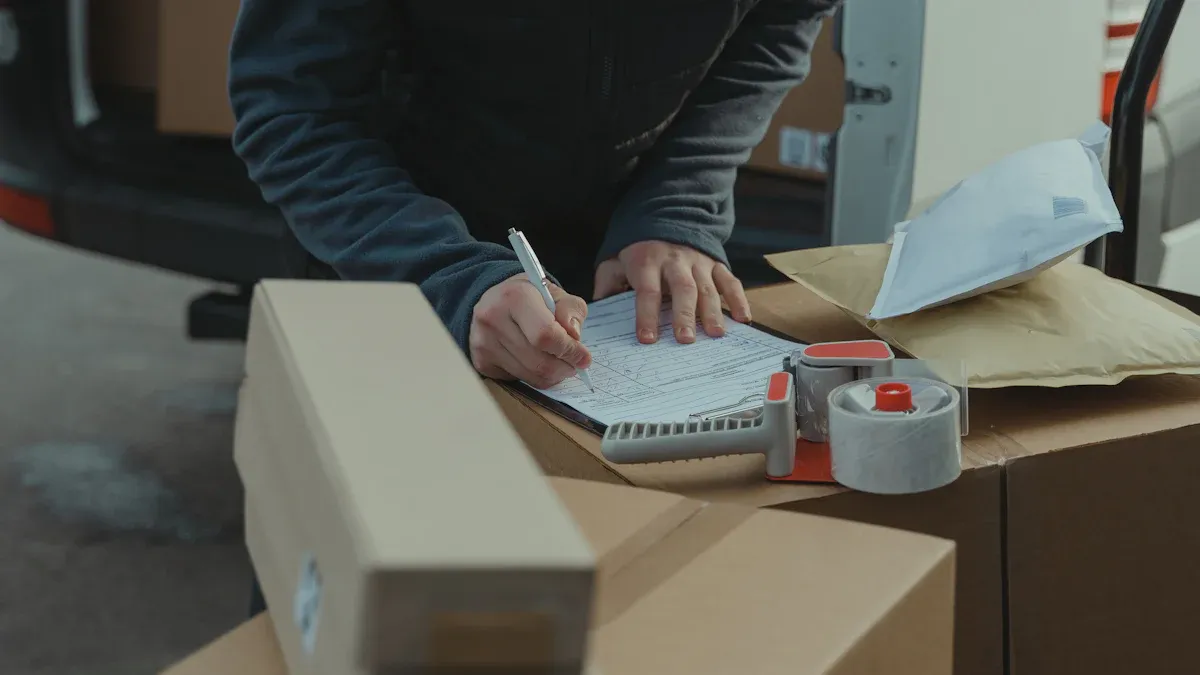How to Ensure Compliance When Shipping Dangerous Goods as Project Cargo

You must follow strict regulations when shipping dangerous goods as project cargo. Accurate identification, correct documentation, certified packaging, and proper labeling protect you from costly mistakes. The U.S. Department of Transportation enforces these rules. Noncompliance can lead to severe penalties. For example, civil penalties may reach $77,114 per violation and can climb to $179,933 if violations cause serious harm. Training your staff and maintaining HAZMAT certification help you avoid these risks and ensure dangerous goods project cargo compliance.
Common Violations | Consequences |
|---|---|
Failing to declare hazardous items | Fines from thousands to over one million dollars |
Inadequate employee training | Escalating penalties for repeat offenses |
Incorrect or missing labels | Major fines from DOT and FAA |
Errors on shipping papers | Civil penalties up to $77,114 per violation |
Using non-UN specification packaging | Penalties up to $179,933 for serious consequences |
Key Takeaways
Accurate identification and classification of hazardous materials are crucial. This helps prevent costly mistakes and ensures compliance with regulations.
Always use UN-approved packaging and correct labeling for dangerous goods. This reduces the risk of fines and shipment delays.
Complete all required documentation, including the Dangerous Goods Declaration and Material Safety Data Sheet. Proper paperwork is essential for legal transport.
Regularly train your staff on HAZMAT regulations and keep training records updated. Well-trained employees help maintain safety and compliance.
Inspect vehicles and cargo spaces before shipping. Regular checks prevent accidents and ensure that all safety standards are met.
Identify and Classify
Hazardous Goods Categories
You need to start with a clear understanding of what counts as dangerous goods. These are substances or materials that pose an unreasonable risk to health, safety, or property during transport. This includes hazardous substances, wastes, marine pollutants, and any material listed under specific hazard classes in the Hazardous Materials Regulations. Knowing these categories helps you avoid mistakes and supports dangerous goods project cargo compliance.
Class | Description |
|---|---|
1 | Explosives |
2 | Gases |
3 | Flammable liquids |
4.1 | Flammable solids |
4.2 | Flammable solids |
4.3 | Flammable solids |
5.1 | Oxidizing substances |
5.2 | Oxidizing substances |
6.1 | Toxic & infectious substances |
6.2 | Toxic & infectious substances |
7 | Radioactives |
8 | Corrosives |
9 | Other substances and articles |
Classification Process
You must follow a step-by-step process to classify your cargo correctly. This process ensures you meet international standards like IMDG and IATA.
Identify the proper shipping name and UN/ID number.
Assign the hazard class or division and packing group, if needed.
Choose the right packaging based on UN specifications or special instructions.
Mark the cargo with the shipping name, UN number, addresses, and quantity.
Label the cargo with hazard and handling labels.
Prepare the required documents, such as the Dangerous Goods Declaration.
Check for any special provisions, placarding, or carrier requirements.
Tip: Always double-check your classification. Mistakes can lead to delays or fines.
Tools and Resources
You have access to several official documents and digital tools to help with identification and classification.
Document Type | Description |
|---|---|
Dangerous Goods Declaration (DGD) | Lists the shipping name, UN number, class, and confirms IMDG compliance. |
Material Safety Data Sheet (MSDS) | Gives details on hazards, handling, and emergency measures. |
Container Packing Certificate | Confirms cargo is packed safely and correctly. |
Bill of Lading (B/L) | Shows the cargo is classified as dangerous goods. |
Packaging certificates | Proves packaging meets UN standards. |
Container marking | Requires placards and labels to show the nature of the cargo. |
You can also use online resources for guidance:
Dangerous Goods Documentation
Shipper's Declaration
FAQs on Dangerous Goods
Transporting Batteries
These tools help you stay organized and support your compliance efforts.
Dangerous Goods Project Cargo Compliance Steps
Regulations Overview
You must follow strict rules when shipping dangerous goods as project cargo. These rules come from both international and national authorities. Each regulation sets standards for how you classify, pack, label, and move hazardous materials. Understanding these rules is the first step toward dangerous goods project cargo compliance.
Regulation | Governing Body | Description |
|---|---|---|
Title 49 (CFR) | U.S. Department of Transportation | Governs the transportation of hazardous materials within the U.S., including handling, shipping, and labeling protocols. |
IMDG Code | International Maritime Organization | Regulates the safe shipping of hazardous goods by sea for international transport, protecting crew and the marine environment. |
ICAO/IATA | International Civil Aviation Organization / International Air Transport Association | Establishes standards for the international air transport of dangerous goods, ensuring safety in air cargo. |
You need to check for updates every year. Regulations change often. For example, new packing instructions and entries appear each January. If you miss these changes, you risk non-compliance. Always review the latest rules before you ship. This habit keeps your dangerous goods project cargo compliance on track.
Note: Regulations from the U.S. Department of Transportation, IMDG, and IATA all apply, depending on your route and mode of transport. You must know which rules fit your shipment.
HAZMAT Certification
You cannot achieve dangerous goods project cargo compliance without trained staff. Every person involved in shipping hazardous materials must complete HAZMAT training. This training teaches your team how to handle, pack, and document dangerous goods safely.
Requirement | Details |
|---|---|
Training Requirement | Mandatory for all personnel involved in shipping dangerous goods. |
Recurrent Training | Required every 24 months to maintain certification validity. |
Competency-Based Training | Ensures training is relevant to job functions and meets high standards. |
You must renew this training every two years. The rules require competency-based learning. This means your team learns skills that match their job. If you skip training or let it expire, you risk fines and shipment delays. Dangerous goods project cargo compliance depends on your staff’s knowledge and certification.
Tip: Keep records of all training and certification. Auditors may ask for proof at any time.
Vehicle and Cargo Space Suitability
You must use the right vehicles and cargo spaces for dangerous goods. Each mode of transport—air, sea, or road—has its own standards. Vehicles must meet guidelines from IATA, IMO, and ICAO. National laws also set rules for local shipments.
Standard/Regulation | Description |
|---|---|
IATA | Guidelines for the safe transport of hazardous cargo by air. |
IMO | Guidelines for the safe transport of hazardous cargo by sea. |
ICAO | Guidelines for the safe transport of hazardous cargo by air. |
National Regulations | Compliance with local laws for the transport of hazardous cargo. |
You need to check that your vehicles are in good mechanical condition. Inspect cargo spaces for leaks, damage, or contamination before loading. Use only approved containers and secure all items to prevent movement. These steps help you avoid accidents and support dangerous goods project cargo compliance.
Alert: Never use damaged vehicles or containers. Even small issues can lead to major safety risks and compliance failures.
By following these steps, you build a strong foundation for dangerous goods project cargo compliance. You protect your team, your cargo, and your business from costly mistakes.
Packaging and Labeling

UN-Approved Packaging
You must use UN-approved packaging for every shipment of dangerous goods. This packaging meets strict performance standards set by international regulations. UN certification shows that the packaging passed tough tests and received approval from a national authority. You see the UN mark on the package, which means it is safe for transport. The packaging must match the type of dangerous goods and the mode of transport, such as air, sea, or road. If you use the wrong packaging, you risk fines and rejected shipments.
Documentation for dangerous goods transport is required for all shipments.
A Material Safety Data Sheet may be needed for some cargo.
Compliance rules can change by country, so work with experienced shipping partners.
Tip: Always check the packaging for the UN mark before loading your cargo.
Labeling and Marking
Correct labeling and marking keep your shipment safe and legal. You must mark each package with the UN or ID number and the proper shipping name. If you use an overpack, mark it with the word "OVERPACK" on the outside. Hazard labels must be square, 100 mm on each side, and show the main hazard class. Handling labels are rectangular and help handlers know how to treat the cargo. For limited quantity shipments, use the right mark for air or ground transport. Missing or incorrect labels often lead to penalties and delays.
Type of Penalty | Description |
|---|---|
Monetary fines imposed for incorrect labeling and marking of dangerous goods. | |
Suspension of Service | Temporary halt of shipping services due to non-compliance. |
Removal of Shipping Privileges | Permanent loss of ability to ship dangerous goods. |
Note: Improper labeling is one of the most common mistakes in dangerous goods project cargo compliance.
Inspection Before Shipping
You must inspect every package and container before shipping. Clean and check the cargo holds for leaks or damage. Remove any traces of previous cargo. Review the Material Safety Data Sheet for each item to plan for safe handling and emergencies. Provide signed certificates for proper packaging and labeling. For containerized cargo, ensure you have a container packing certificate. These steps help you avoid accidents and keep your shipment compliant.
Inspection Area | Requirements |
|---|---|
Hold Preparation | Clean and inspect holds, remove old cargo, check for leaks and damage. |
Shipper Responsibilities | Provide signed certificates for packaging and labeling. |
Material Safety Data Sheets | Supply MSDS before loading, review for safety and emergency planning. |
Alert: Skipping inspection can lead to safety risks and regulatory violations.
Documentation and Training
Dangerous Goods Declaration (DGD)
You must prepare a Dangerous Goods Declaration (DGD) for every shipment of hazardous project cargo. This document confirms that you have identified, classified, and packaged the goods correctly. The DGD is essential for legal and safe transport. In emergencies, responders use the DGD to understand the risks and handle the situation safely.
Regulatory penalties may result from incorrect documentation.
Serious safety hazards can arise from improper handling.
Tip: Always double-check the DGD for accuracy before shipping. Mistakes can lead to costly delays and fines.
Material Safety Data Sheet (MSDS)
You need to include a Material Safety Data Sheet (MSDS) with your shipment. The MSDS gives workers and emergency personnel the information they need to handle hazardous materials safely. It covers identification, hazards, first-aid, fire-fighting, spill response, handling, storage, and more.
Key sections in an MSDS:
Identification and supplier contact
Hazard classification and warning labels
Chemical composition
First-aid measures
Fire-fighting instructions
Spill and release procedures
Handling and storage guidelines
Personal protective equipment
Physical and chemical properties
Stability and reactivity
Toxicological data
The MSDS helps everyone stay safe and ensures you meet compliance requirements.
Intent to Ship Form
You must complete an Intent to Ship form before moving dangerous goods. This form notifies carriers and authorities about your shipment. It helps coordinate logistics and ensures all parties know the risks involved.
Description | |
|---|---|
Safety Data Sheet (SDS) | Details safe handling and disposal of hazardous goods. |
Dangerous Goods Declaration (DGD) | Confirms correct identification, classification, and packaging. |
Multimodal Dangerous Goods Form | Used for shipments involving multiple transport modes. |
Container or Vehicle Packing Certificate | Verifies safe packing of containers or vehicles. |
Staff Training and Records
You must train all staff involved in handling dangerous goods. Training covers hazard recognition, accident prevention, and regulatory compliance. Staff must complete hazmat training every three years. Ongoing education builds a strong safety culture and reduces risks.
Keep accurate records of all training and packaging methods.
Maintain documentation for audits and inspections.
Regular training helps prevent accidents and legal issues.
Note: Proper training and recordkeeping protect your business and support safe project cargo operations.
Safety and Pitfalls

Emergency Planning
You must prepare for emergencies when shipping dangerous goods as project cargo. Emergency planning protects your team and the environment. You need to follow strict procedures set by international codes. Ships carrying hazardous materials must use the Emergency Response Procedures for Ships Carrying Dangerous Goods (EmS) Guide. This guide gives you clear steps for handling fires and spills. The International Maritime Dangerous Goods (IMDG) Code requires you to set safety measures before transport. The International Safety Management (ISM) Code makes you keep a Safety Management System (SMS) that includes emergency response plans.
Emergency Planning Requirement | Details |
|---|---|
EmS Guide | Guidance for fires, spills, and other incidents involving dangerous goods |
IMDG Code | Safety measures for handling and transport |
ISM Code | Safety Management System with emergency procedures |
Tip: Review your emergency plans before every shipment. Practice drills with your team to stay ready.
Insurance
You need special insurance for dangerous goods project cargo. Hazardous cargo brings unique risks to public safety and the environment. International codes like IMDG and IATA set strict rules for coverage. Standard cargo insurance does not cover these risks. You must choose a policy that protects against accidents, spills, and regulatory fines.
Aspect | Hazardous Cargo | Standard Cargo |
|---|---|---|
Unique Risks | Risks to public safety and environment | Lower risk profile |
Regulatory Framework | IMDG and IATA regulations | Fewer regulations |
Insurance Coverage | Specialized insurance required | Standard policies suffice |
Note: Always check your insurance policy for exclusions. Make sure your coverage matches the type of dangerous goods you ship.
Common Mistakes
You can avoid costly errors by knowing the most frequent compliance mistakes. Many shippers forget to use UN specification packaging. Others mark and label packages incorrectly. Some skip closure instructions or fail to train their hazmat employees. Not registering with the U.S. Department of Transportation is another common issue.
Not using UN specification packaging
Incorrect marking and labeling
Ignoring closure instructions
Failing to train hazmat employees
Not registering with PHMSA
To prevent these mistakes, use automated risk assessment tools and cargo classification systems. Monitor documentation and labeling with automated checks. Stay updated on regulations from IMDG, ADR, and DOT HMR. Train your staff regularly and keep clear communication among all stakeholders.
Alert: Proactive compliance and ongoing training help you avoid penalties and keep your shipments safe.
You can ensure dangerous goods project cargo compliance by following these steps:
Identify and classify hazardous materials accurately.
Use UN-approved packaging and correct labeling.
Complete all required documentation.
Train your staff and keep records up to date.
Inspect vehicles and cargo spaces before shipping.
Stay diligent. Consult experts for complex shipments. For ongoing compliance, you should:
Conduct regular audits.
Invest in training and technology.
Analyze incidents and improve your processes.
Keep monitoring your compliance program to protect your business and everyone involved.
FAQ
What is the most common mistake when shipping dangerous goods as project cargo?
You often see incorrect labeling or missing documentation. These errors can cause shipment delays and heavy fines. Always double-check labels and paperwork before shipping.
Do you need special training to handle dangerous goods?
Yes. You must complete HAZMAT training and keep your certification current. This training helps you understand how to pack, label, and document hazardous cargo safely.
How often should you inspect vehicles and containers?
You should inspect vehicles and containers before every shipment. Look for leaks, damage, or contamination. Regular checks help you avoid accidents and stay compliant.
What documents must you include with your shipment?
You need these documents:
Dangerous Goods Declaration (DGD)
Material Safety Data Sheet (MSDS)
Intent to Ship form
Packing certificates
Can you ship dangerous goods internationally without following IMDG or IATA rules?
No. You must follow IMDG for sea and IATA for air shipments. These rules protect people and the environment. Non-compliance can result in rejected cargo and legal action.
See Also
Rely On PGL For Safe And Compliant HAZMAT Shipping
Key Strategies For Effective Global Logistics Operations
PGL's Key LCL Shipping Steps For Panama Exports
PGL's Solutions For Breakbulk And Out-Of-Gauge Shipping
Comprehensive Ocean Export Services For FCL And LCL Shipments
